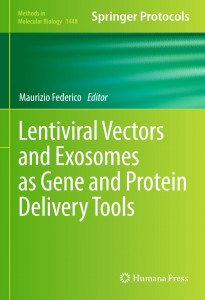
1. Coscia, C., et al. (2016). "Generation, Quantification, and Tracing of Metabolically Labeled Fluorescent Exosomes." Methods Mol Biol 1448: 217-235.
Over the last 10 years, the constant progression in exosome (Exo)-related studies highlighted the importance of these cell-derived nano-sized vesicles in cell biology and pathophysiology. Functional studies on Exo uptake and intracellular trafficking require accurate quantification to assess sufficient and/or necessary Exo particles quantum able to elicit measurable effects on target cells. We used commercially available BODIPY((R)) fatty acid analogues to label a primary melanoma cell line (Me501) that highly and spontaneously secrete nanovesicles. Upon addition to cell culture, BODIPY fatty acids are rapidly incorporated into major phospholipid classes ultimately producing fluorescent Exo as direct result of biogenesis. Our metabolic labeling protocol produced bright fluorescent Exo that can be examined and quantified with conventional non-customized flow cytometry (FC) instruments by exploiting their fluorescent emission rather than light-scattering detection. Furthermore, our methodology permits the measurement of single Exo-associated fluorescence transfer to cells making quantitative the correlation between Exo uptake and activation of cellular processes. Thus the protocol presented here appears as an appropriate tool to who wants to investigate mechanisms of Exo functions in that it allows for direct and rapid characterization and quantification of fluorescent Exo number, intensity, size, and eventually evaluation of their kinetic of uptake/secretion in target cells.
2. Dreyer, F. and A. Baur (2016). "Biogenesis and Functions of Exosomes and Extracellular Vesicles." Methods Mol Biol 1448: 201-216.
Research on extracellular vesicles (EVs) is a new and emerging field that is rapidly growing. Many features of these structures still need to be described and discovered. This concerns their biogenesis, their release and cellular entrance mechanisms, as well as their functions, particularly in vivo. Hence our knowledge on EV is constantly evolving and sometimes changing. In our review we summarize the most important facts of our current knowledge about extracellular vesicles and described some of the assumed functions in the context of cancer and HIV infection.
3. Malik, Z. A., et al. (2016). "Cardiac Myocyte Exosome Isolation." Methods Mol Biol 1448: 237-248.
Exosomes are cell-derived small extracellular membrane vesicles (50-100 nm in diameter) actively secreted by a number of healthy and diseased cell types. Exosomes can mediate cellular, tissue, and organ level micro communication under normal and pathological conditions by shuttling proteins, mRNA, and microRNAs. Prior to vesicle molecular profiling, these exosomes can be isolated from conditioned cell media or bodily fluids such as urine and plasma in order to explore the contents and functional relevance. Exosome purification and analyses are a fast-growing research field. Regardless of several advances in exosome purification and analyses methods, research still faces several challenges. Despite tremendous interest in the role of extracellular vesicles, there is no general agreement on dependable isolation protocols. Therefore, there is an urgent need to establish reliable protocol of exosome purification and analysis. Here, we report a simple cost-effective isolation and analysis of cardiac myocyte exosomes from conditioned media.
4. Manfredi, F., et al. (2016). "Incorporation of Heterologous Proteins in Engineered Exosomes." Methods Mol Biol 1448: 249-260.
Engineering exosomes to upload heterologous proteins represents the last frontier in terms of nanoparticle-based technology. A limited number of methods suitable to associate proteins to exosome membrane has been described so far, and very little is known regarding the possibility to upload proteins inside exosomes. We optimized a method of protein incorporation in exosomes by exploiting the unique properties of a nonfunctional mutant of the HIV-1 Nef protein referred to as Nef(mut). It incorporates at high extents in exosomes meanwhile acting as carrier of protein antigens fused at its C-terminus. Manipulating Nef(mut) allows the incorporation into exosomes of high amounts of heterologous proteins which thus remain protected from external neutralization/degradation factors. These features, together with flexibility in terms of incorporation of foreign antigens and ease of production, make Nef(mut)-based exosomes a convenient vehicle for different applications (e.g., protein transduction, immunization) whose performances are comparable with those of alternative, more complex nanoparticle-based delivery systems.
5. Ohno, S. and M. Kuroda (2016). "Exosome-Mediated Targeted Delivery of miRNAs." Methods Mol Biol 1448: 261-270.
Many types of cells release phospholipid membrane vesicles that are thought to play key roles in cell-cell communication, antigen presentation, and the spread of infectious agents. These membrane vesicles, derived from the late endosomes, are called exosomes. Various proteins, messenger RNAs (mRNAs), and microRNAs (miRNAs) are carried by exosomes to cells in remote locations, like a message in a bottle. Because they can protect encapsulated small RNAs from ribonucleases (RNases) in body fluid, exosomes represent ideal carriers for nucleic acid drugs. In addition, because exosomes are constructed from self components, they are predicted to have low antigenicity and toxicity, extremely important properties for carriers used in drug delivery. This article describes a protocol for using exosomes as carriers for RNA drug delivery systems.
独立章节及正本书下载地址:http://www.exosome.com.cn/forum.php?mod=viewthread&tid=889&extra=&_dsign=5393231c




